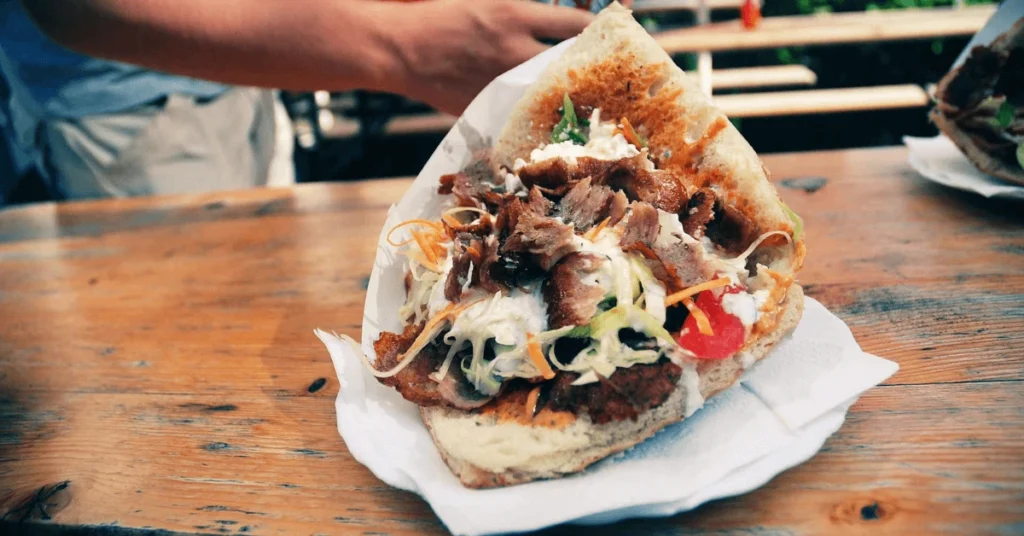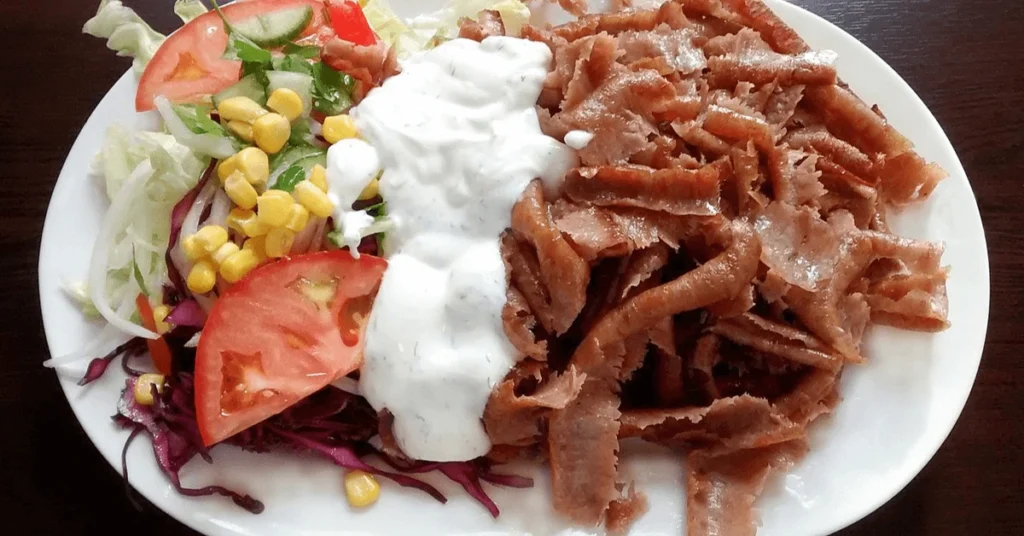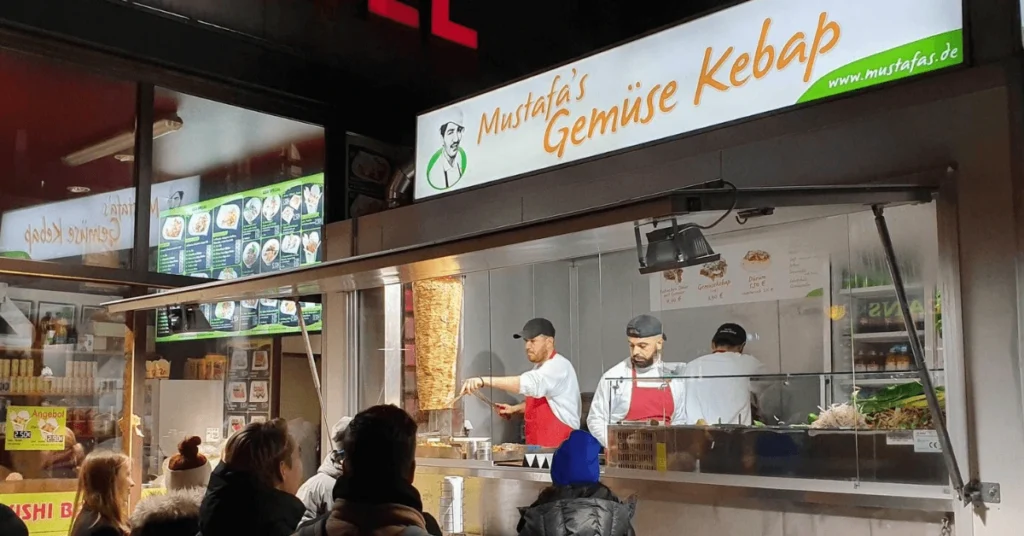Discover the Berliner Kebap: a culinary masterpiece that embodies the vibrant essence of Berlin’s food scene. This dish represents a delectable fusion of traditional Turkish kebab with a distinctive German twist, offering a healthier, yet satisfying alternative to conventional fast food. Characterized by its use of fresh, quality ingredients, the Berliner Kebap combines savory meats, crisp vegetables, and tantalizing sauces in a fluffy, slightly toasted flatbread. Experience a taste journey that promises more than just a meal, but an unforgettable exploration of flavor right from the first bite.
History of Berliner Kebap
As a food enthusiast, I’ve always been captivated by the origins of beloved dishes, and the Berliner Kebap is no exception. This succulent treat has pierced the fabric of Berlin’s culinary scene with its flavorful skewers of chicken, beef, and lamb. Let me take you back to its roots.
In the early 1970s, Turkish immigrants in Berlin adapted the traditional Turkish kebap to German tastes by making it with either beef or turkey and serving it in bread. The vertical roasting style allowed for a distinctive cook on the meat, resulting in a delicious combination of tender and crisp. The concept quickly caught on and has since undergone various iterations, with chicken becoming a popular choice alongside beef and lamb.
A snapshot of its popularity:
- Over 4,000 kebab shops in Berlin
- Berliners consume around 60 tonnes of döner meat daily
The reputation of the Berliner Kebap has grown impressively, establishing it as not just street food, but an iconic symbol of Berlin’s rich, multicultural gastronomy. Moving past mere sustenance, it has become a culinary emblem for both locals and visitors alike, reflecting a fusion of traditions that is the essence of the city’s dynamic food culture.
Ingredients and Varieties
When I think of Berliner Kebap, my palate tingles with anticipation. It’s a savory, delectable dish where the blend of seasoned meats, crisp veggies, and zesty sauces creates a symphony in every bite. The beauty of this German street food classic lies in its versatility—whether you crave the rich flavors of meat or prefer a vegetarian feast, there’s a variation just for you.
Meat Variations
Beef: A staple in the Berliner Kebap universe, beef is often seasoned with a mix of spices like cumin and pepper for a rich, deep flavor. The meat is typically roasted to succulent perfection before being thinly sliced into the bread.
- Chicken: Treasured for its lighter taste, chicken in Berliner Kebap is marinated and grilled to golden-brown, imbuing it with a smokey essence that dances on the tongue.
- Lamb: For those that savor a stronger, more aromatic meat, lamb is a traditional option. It’s usually seasoned and cooked until it reaches a mouth-watering tenderness that’s hard to resist.
Here’s a recipe to make your own Berliner Doner Kabab.
Vegetarian Options
Veggies: My vegetarian friends rejoice, as a Berliner Kebap can be just as satisfying without meat. Imagine a medley of roasted vegetables, such as bell peppers, onions, and zucchini, all nestled within a warm, fluffy flatbread.
- Vegetarian: There are plenty of non-meat fillers that can take center stage in a Berliner Kebap. Options like falafel, halloumi cheese, or seasoned tofu provide a delicious protein punch that caters to all palates.
A house of authentic kebabs shares that a kebap can be customized to your preferences, celebrating the variety that Berliner Kebap stands for.

Nutritional Information
When I think about indulging in a delicious Berliner Kebap, it’s not just the mouth-watering taste that captures my attention; it’s the rich nutritional profile of the meats and veggies that make it a truly satisfying meal. Let’s break down the healthful components that create this dish’s distinctive flavor and nourishing appeal.
Meat Nutrients
- Beef: Typically, a serving contains high-quality protein, essential amino acids, and is a good source of iron and B vitamins which are vital for energy production and muscle maintenance.
- Chicken: It’s lower in fat compared to beef and is packed with protein, selenium, and phosphorus for bone health.
Veggie Nutrients
- Tomatoes: These bring a burst of flavor and are loaded with vitamin C, potassium, and lycopene, an antioxidant linked to reduced risk of chronic diseases.
- Cabbage: Adds crunch and fiber, plus it’s rich in vitamin K, important for bone health, and vitamin C for immune function.
Preparation Techniques
When I think of Berliner Kebap, it strikes me not just as a delicious meal, but as an art form that’s perfected on the streets of Berlin. To create kebap that genuinely captures the essence of this city, every detail, from ingredients to the precise method of cooking, needs careful consideration.
Firstly, it’s the meat. Marinating it is an essential step, where flavors of garlic, cumin, and oregano play their part. Meat—typically a mixture of veal, chicken, or lamb—is stacked layer by layer on a vertical rotisserie and seasoned meticulously with a blend of spices, ensuring every slice is imbued with taste.
Here’s how the assembly typically goes:
- Bread: A warm, tanned flatbread plays host to the vibrant contents.
- Meat: Rotisserie-grilled, this spiced spectacle is sliced right off the skewer, piping hot.
- Vegetables: Crisp lettuce, juicy tomatoes, and slivers of cucumber add a refreshing crunch.
- Sauce: A drizzle of herb-infused yogurt or a spicy sauce ties it all together.
For the ultimate freshness in a Berliner Kebap, every element needs to sing with flavor. It’s that unmistakable crunch of veggies against the tenderness of the meat, the tangy zip of sauce, all cocooned in bread just right. It is, after all, a symphony of textures and tastes that Berlin has mastered well.
Cooking kebap this way not only honors tradition but assures you get a bite of Berlin in every morsel. What started as a simple meal has now become a culinary icon, thanks to these careful preparation techniques that never fail to create a standout kebap.
Serving Styles
When I step into Berliner Kebap, the variety of serving styles instantly catches my eye. Each dish showcases the vibrant, hearty core of what kebap is all about – a delicious harmony of flavors served up in a way that suits every craving.
Kebap Plate
The Kebap Plate is a feast for the senses. It’s a heartwarming mix of succulent meats, fresh veggies, and flavorful sauces artfully arranged on a plate. The meat, whether chicken or beef, is always tender and seasoned to perfection. Accompanied by a generous helping of crispy fries, this dish is a complete meal that not only satisfies hunger but also offers a visually appealing experience.
Kebap Sandwich
Berliner Kebap’s Sandwich is nothing short of a handheld delight. It comes wrapped in a warm, slightly crisp bread that complements the fillings within. The balance of juicy meat, crisp vegetables, and rich sauce in every bite transports me straight to the streets of Berlin, where this dish is a classic favorite.
French Hot Dog
Lastly, the French Hot Dog stands out as a unique twist on the traditional hot dog. A mouthwatering sausage is nestled in a fluffy bun, drizzled with tasty sauces, and finished with a sprinkle of crispy fried onions. This is not your average hot dog; it’s a Berliner Kebap treat that combines the simplicity of street food with a dash of culinary creativity.
Whether it’s a plateful of mixed flavors, a sandwich on the go, or a playful hot dog, Berliner Kebap serves up a variety of dishes to cater to every taste.

Popular Locations
When I first landed in Berlin, one of my culinary missions was to discover the tastiest Berliner Kebap in the city. It’s a beloved dish here, and the sheer number of kebab spots might astonish newcomers. If you wander around neighborhoods like Kreuzberg or Neukölln, every corner seems to boast its own version of this iconic street food.
- Imren Grill: One place that always comes up in conversation is Imren Grill, a haven for kebab lovers. It’s not just about the food; it’s the lingering aroma of spiced meat that hugs you the moment you walk in.
- Mustafa’s Gemüse Kebap: Arguably, Mustafa’s Gemüse Kebap is another joint that’s reached an almost legendary status. The queues are testament to that, with patience rewarded by a mouth-watering kebab experience.
- Berlin’s Best Döner: If you’re looking for a more wide-ranging sampling, visiting Berlin’s Best Döner spots can offer a delightful journey through the city. From lunchtime fixes to after-party cravings at 2 AM, there’s always a kebab shop to satisfy your hunger.
Each location serves up a slice of Berlin in its own unique way. I’ve found that part of the joy is in the search itself, meandering through the city’s bustling streets, uncovering not just a dish, but a piece of Berlin’s heart with every bite.

Comparison to Other Cuisines
When I first tasted a Berliner Kebap, I knew it was more than just fast food—it was a culinary experience, blending tradition with global flavors. Each culture adds its own twist to the classic dish, creating a fascinating interplay of tastes.
Chinese Kebap
In Chinese cuisine, the kebap gets a twist with the introduction of spices like Szechuan pepper and hoisin sauce. The meat, often lamb or chicken, is laced with potent seasonings and sometimes served with stir-fried vegetables, offering a bold contrast to the Berliner Kebap’s focus on fresh, simple ingredients.
Japanese Kebap
The Japanese kebap, on the other hand, mirrors the elegance of Japanese culinary arts. In Tokyo’s restaurants, you might find kebap skewers seasoned with a delicate blend of soy, mirin, and a hint of wasabi, complemented by pickled vegetables, which provide a crisp counterbalance to the savory meat.
Mexican Kebap
Down in Mexico, chefs infuse the kebap with vibrant flavors such as chipotle or cilantro, giving the dish a zesty kick. Mexican kebaps might feature slow-cooked pork or beef and are often garnished with fresh salsa, lime, and avocado, echoing the spirited essence of Mexican street food.

Frequently Asked Questions
When I first tried Berliner Kebap, the blend of flavors and textures was a delightful surprise. Let me share with you what makes this dish special, how much you might spend on it, and the variety you can expect.
What are the key ingredients in a traditional Berliner Kebap?
The cornerstone of any Berliner Kebap is the meat, often beef or chicken, seasoned with a mix of herbs and spices, then cooked on a vertical rotisserie. Fresh vegetables, like lettuce, cabbage, onions, and tomatoes, along with yogurt- or tomato-based sauces, are wrapped together with the meat in a flatbread, often called ‘fladenbrot’.
What is the average price range for a Berliner Kebap?
The price of a Berliner Kebap can vary depending on where you’re ordering, but generally, you’ll find them priced from $5 to $10. This provides a satisfying, cost-effective meal option for many hungry folks out there.
What are some popular items on a Berliner Kebap menu?
Apart from the classic kebap, you’ll often find variations like the Döner Box, which has meat, veggies, and sauces over rice or fries, and side dishes like Falafel and Börek, which are perfect complements to the main dish.
How does Berliner Kebap differ from other types of doner kebab?
Berliner Kebap typically uses a distinctive set of seasonings and may offer a slightly different bread choice than other doner kebabs. The emphasis is always on a balance of flavors and the freshness of ingredients, making it stand out in the wide world of kebaps.
If you liked this blog post about the topic: Berliner Kebap, don’t forget to leave us a comment down below to tell us about your experience with it.






